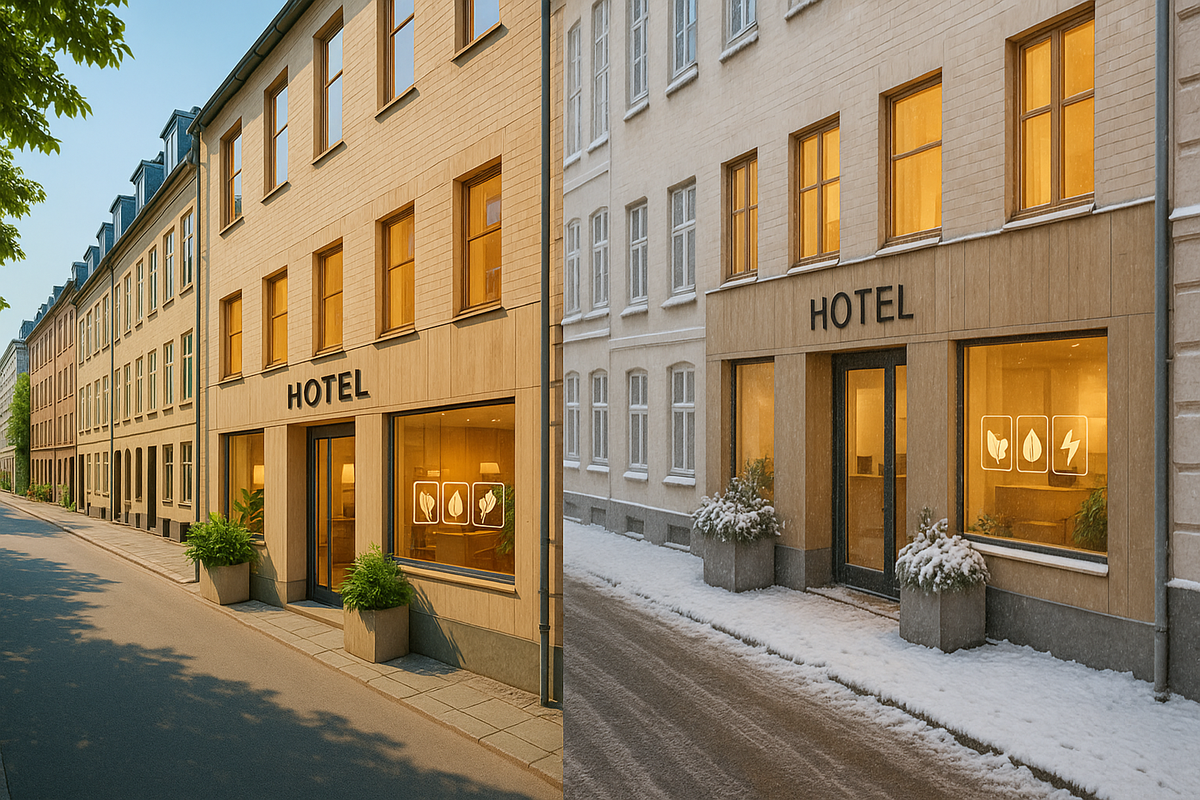🌿Green hotels: how to choose eco-certified accommodation without overpaying
✨ What is a “green” hotel in the Danish sense?
In Denmark, an “eco-hotel” is not “plants in the lobby,” but verifiable standards. Two main signs to look for:
- Green Key is an international eco-labeling standard for tourism: hotels, hostels, convention centers. Certification is based on dozens of criteria, ranging from energy, water, and waste to cleaning chemicals, cuisine, and staff training. The criteria are transparent and apply to different categories of facilities.
- Nordic Swan Ecolabel (Nordic Swan) is the “official” Nordic eco-label. For hotels, there are thresholds for energy consumption/m², water, unsorted waste, eco-labeled detergents, policies on disposable goods, etc. The requirements are regularly updated and tightened.
Add to this local initiatives: Organic Cuisine Label (percentage of organic food in the kitchen), skip cleaning programs (skip daily cleaning — save resources, sometimes get a voucher/bonus). As a result, “green” here means audited figures and processes, not advertising slogans.

🌿 Where to find “default” certification (brands and examples)
- Scandic is the largest Nordic chain. 95–96% of hotels are already Nordic Swan certified; the brand has public goals to reach 100%, as well as programs to reduce water/chemical use (including through “cleaning on demand”). If you want “no surprises” in terms of ecology and a clear price, this is a good start.
- Comwell is a Danish chain. All Danish hotels are Green Key certified, and the chain's restaurants have the Organic Cuisine Label (bronze). Plus points for frequent “weekday” rates and a clear ESG policy.
- Brøchner Hotels (SP34, Ottilia, etc.) — Green Key, with an emphasis on renewable energy and no single-use plastics; there is often a “wine hour” for guests.
- Guldsmeden Hotels (Axel, Babette, Bryggen, Manon Les Suites) — Green Globe + Green Key, high percentage of organic products (Golden Ø) in the kitchen; “eco-boho” aesthetic.
- Copenhagen Admiral Hotel — a historic warehouse on the waterfront, participant in Green Key; an example of how a “legendary address” can also be “green.”
- Strawberry (formerly Nordic Choice — Clarion, Comfort, etc.) — the group has systemic sustainability (ISO 14001, etc.), some of the properties in Denmark also have eco-labels; always check the card for a specific hotel.
Outside the capital, check out Green Solution House (Bornholm) — a great example of a “circular” hotel (energy, water, materials).
💸 How not to overpay for “green” — rules of thumb
- Go for the off-peak days and weekdays. January–March and late October–mid-November are the mildest; the second window is April and September. On Fridays and Saturdays in the summer, prices “run away,” even in the eco-segment.
- Avoid peak weeks. In Copenhagen, prices rise significantly in the first week of June (Distortion) and in mid-August (Pride Week), especially in Indre By/Vesterbro/Nørrebro. Shift to weekdays during these weeks or choose areas 1-2 stations further away.
- Look at the brand, not the “eco-super-luxury.” For chains with large-scale certification (Scandic, Comwell), eco-friendliness does not cost more than the category — it is a basic standard. Boutique properties with “eco + design + center” are significantly more expensive in July and August.
- Use “green” options. Skipping daily cleaning, refusing towel changes, water in jugs — these often give bonuses/vouchers and really reduce the impact.
- Check what is actually included. An eco-breakfast with organic products, waste sorting in the room, dispensers instead of mini-plastic bottles, and an energy-saving thermostat menu are not “fads” but criteria for eco-labels.

🧩 Table “brand × certificate × when to catch low prices”
🌿 Brands and eco labels in Copenhagen
| Brand/hotel | Certificate(s) | What it means for the guest | When it’s cheaper |
|---|---|---|---|
| Scandic (several locations) | Nordic Swan | strict limits on energy/water/chemicals; housekeeping “on request” | Jan–Mar · Apr/Sep–Oct, weekdays |
| Comwell (Portside etc.) | Green Key + Organic Cuisine Label (bronze) | organic-forward menus, transparent ESG processes | winter · shoulder season, weekdays |
| Brøchner (SP34, Ottilia) | Green Key | heritage buildings + sustainability; often a “wine hour” | Mar–May, Sep–Oct (weekdays) |
| Guldsmeden (Axel, Babette, Bryggen…) | Green Globe + Green Key | eco-boho style, high share of organic food in the kitchen | winter · shoulder season |
| Admiral Hotel | Green Key | “waterfront history” + certified sustainability | Mar–Apr · September (weekdays) |
| Strawberry (Clarion/Comfort) | ISO 14001 / some properties also Green Key | systemic sustainability; check the individual property page | weekdays year-round |
Note: specific promotions/rates depend on dates and events (Distortion/PRIDE/December).
🧠 How to check ‘eco’ without unnecessary stress (and avoid greenwashing)
- Look for the sign and number: Green Key/Nordic Swan have unified registries; the hotel has an up-to-date logo/mention of the certificate on its official website.
- Look at the substance, not the posts: waste sorting, dispensers instead of mini-bottles, eco-friendly cleaning products, ‘on request’ linen/cleaning policy, organic breakfast options — these are the hallmarks of a ‘green’ hotel.
- Check what's “included”: sometimes there is a charge for an ‘eco-breakfast’; it is more profitable to take the ‘night + breakfast on weekdays’ package.
- ‘Long weekend’ scenario: if you need Friday-Saturday in the summer, try a split booking — 1-2 nights by the water, the rest — in a quieter area/near the metro (M3/M4).
- Families: the availability of skip cleaning + quiet courtyard + lift/ramps is more important than being in the ‘super centre’.
🧩 Check eco-certification in 60 seconds
✅ Checklist (save this)
- Open the hotel’s page → find the Green Key or Nordic Swan logo and check the validity period.
- Check in the official registry (by name/city) that the property is actually certified.
- Clarify the details: housekeeping on request, refillable dispensers, in-room recycling, share of organic products at breakfast.
- Check the dates: weekdays in Jan–Mar and Sep–Oct are usually noticeably cheaper; avoid Distortion/PRIDE weeks.
- Ask about rewards for a “green choice”: voucher/drink/points for declining daily housekeeping.
🗺️ Short scenarios for ‘eco without overpaying’
- 3–4 days ‘for the first time’ (spring/autumn, weekdays): Scandic in the centre/near the metro (Nordic Swan) — basic ‘greenery’ without extra charges; if you want more character, add a night at SP34/Ottilia on weekdays.
- Summer by the water (budget-friendly): Comwell Portside (Green Key) in Nordhavn on weekdays — walks by the water, M4 to the centre; on weekends — move 1–2 stops away from Nyhavn.
- Eco-comfort and organic: Guldsmeden (Green Globe + Green Key) — choose January–March or October, check wellness slots; more expensive in summer due to demand.
- History + a green approach: Admiral (Green Key) — the best compromise in March–April/September (weekdays): a view of the harbour without the summer surcharge.
❓FAQ
No. Green Key is an international tourism standard (hotel, hostel, conference centre, etc.). Nordic Swan is an official Nordic eco-label with industry thresholds for hotels. Both are third-party and are regularly updated.
Not necessarily. For chains such as Scandic, certification is the ‘base,’ and the price is determined by location/season. The extra cost is more often associated with the boutique factor (design + city centre in summer) than with ‘green’ features.
On the hotel's official website and in the Green Key / Nordic Swan registers (by name). The validity period and scope (hotel, restaurant, conferences) are also visible there.
Both: less laundry (water/energy), fewer chemicals, fewer disposables. Large chains advertise this and offer bonuses.
January–March and weekdays in autumn (late October–mid-November). Keep in mind that events such as Distortion (early June) and Pride (mid-August) make summer weekends expensive and noisy.
Are there dispensers instead of mini-plastic bottles, A/C in July–August (not always in historic buildings), organic breakfast, recycling in the room, cleaning on request.
For inspiration, check out the Green Solution House on Bornholm: a ‘circular’ hotel where ecology is not a function, but rather the architecture and operational processes.





0 comments
Log in to leave a comment